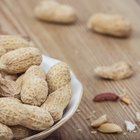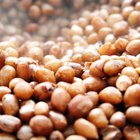The macadamia nut is native to Australia. The trees were first introduced to America in the early 20th century when farmers began commercial cultivation in Hawaii. Macadamia nuts are extremely nutritious, with a high amount of beneficial fatty acids as well as calcium, iron and B vitamins. Macadamia nut shells can be used to make carbon and plastic products, and recent innovations in fuel production use shells from processing plants that would otherwise be discarded.
Activated Carbon
Macadamia nut shells are burned at very high temperatures to create activated carbon and charcoal. This highly porous material is most often used in making carbon filters for water and air purification. Macadamia nut carbon filters have both domestic and industrial applications, and activated carbon is also used to collect samples of toxins for air and water quality testing.
Fertilizer and Mulch
Macadamia nut shells can be used for mulch and fertilizer. The shells are composted to break them down, then are used in gardens to help retain moisture and restrict weed growth. The shells can also be ground to use as fertilizer in macadamia nut orchards because the shells contain the nutrients from the soil they grew in, and they effectively return these nutrients to the soil for new crops.
Green Plastics
Macadamia nut shells left over from processing can be used in the production of environment-friendly plastics. The shells are ground into a fine powder, then mixed with a polymer to create a plastic. Green plastics from macadamia nut shells are a relatively new innovation and are mostly used for handmade crafts. Even though they are a renewable resource, production is difficult and expensive and the quality of the resulting product is too low and inconsistent for mass production.
Cooking Fuel
The high oil content of macadamia nuts causes them burn slowly and hot, which makes them a good source of cooking fuel. The shells can be used as charcoal for grilling because the embers last a long time and the smoke doesn’t leave an unpleasant taste on food. They are also a good addition to fuel for pit-roasting meats because they are suitable for the long cooking times needed.
Green Electricity
Companies in Australia, New Zealand and Hawaii are currently experimenting with nut shells to be burned for generating greener electricity from a renewable source. The shells are burned to heat water in boilers and the steam is used to power generators. The moisture content in the shells is not consistent, so the boilers have to be specially designed to accommodate macadamia nut shells. Currently, the fuel is being used to power macadamia nut production plants, with the leftover fuel going into the power grid for home use.
Related Articles

Types of Biodegradable Products

What Is Polyurethane Coated Leather?

Can Peanut Shells Be Used for Compost?

How Does Cotton Help Insulate?

The Effects of Organic Fertilizer on ...

Heating Foods in Plastic & BPA

Kinetic Watches Vs. Eco-Drive Watches

List of Ways to Conserve Mother Nature

Appliances That Use Solar Energy

How to Cook Dried Chickpeas Without a ...

Why Do Cashews Cost More Than Peanuts?

Advantages of Vermicompost

Purpose of Moth Balls

Environmental Impact of Disposable ...

Disadvantages of Using Plastic Bags

How to Remove a Cardamom Seed From a Pod

What Is a Hickory Nut?

How to Make Charcoal Paper

The Disadvantages of Vermicompost

What Are the Uses of Vermicompost?
References